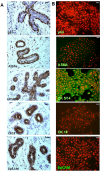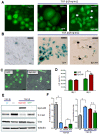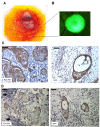EpCAM overexpression prolongs proliferative capacity of primary human breast epithelial cells and supports hyperplastic growth
- PMID: 23758908
- PMCID: PMC3702434
- DOI: 10.1186/1476-4598-12-56
EpCAM overexpression prolongs proliferative capacity of primary human breast epithelial cells and supports hyperplastic growth
Abstract
Introduction: The Epithelial Cell Adhesion Molecule (EpCAM) has been shown to be strongly expressed in human breast cancer and cancer stem cells and its overexpression has been supposed to support tumor progression and metastasis. However, effects of EpCAM overexpression on normal breast epithelial cells have never been studied before. Therefore, we analyzed effects of transient adenoviral overexpression of EpCAM on proliferation, migration and differentiation of primary human mammary epithelial cells (HMECs).
Methods: HMECs were transfected by an adenoviral system for transient overexpression of EpCAM. Thereafter, changes in cell proliferation and migration were studied using a real time measurement system. Target gene expression was evaluated by transcriptome analysis in proliferating and polarized HMEC cultures. A Chicken Chorioallantoic Membrane (CAM) xenograft model was used to study effects on in vivo growth of HMECs.
Results: EpCAM overexpression in HMECs did not significantly alter gene expression profile of proliferating or growth arrested cells. Proliferating HMECs displayed predominantly glycosylated EpCAM isoforms and were inhibited in cell proliferation and migration by upregulation of p27(KIP1) and p53. HMECs with overexpression of EpCAM showed a down regulation of E-cadherin. Moreover, cells were more resistant to TGF-β1 induced growth arrest and maintained longer capacities to proliferate in vitro. EpCAM overexpressing HMECs xenografts in chicken embryos showed hyperplastic growth, lack of lumen formation and increased infiltrates of the chicken leukocytes.
Conclusions: EpCAM revealed oncogenic features in normal human breast cells by inducing resistance to TGF-β1-mediated growth arrest and supporting a cell phenotype with longer proliferative capacities in vitro. EpCAM overexpression resulted in hyperplastic growth in vivo. Thus, we suggest that EpCAM acts as a prosurvival factor counteracting terminal differentiation processes in normal mammary glands.
Figures






Similar articles
-
Phenotype-dependent effects of EpCAM expression on growth and invasion of human breast cancer cell lines.BMC Cancer. 2012 Oct 30;12:501. doi: 10.1186/1471-2407-12-501. BMC Cancer. 2012. PMID: 23110550 Free PMC article.
-
Epithelial-to-mesenchymal transition induced by TGF-β1 is mediated by AP1-dependent EpCAM expression in MCF-7 cells.J Cell Physiol. 2015 Apr;230(4):775-82. doi: 10.1002/jcp.24802. J Cell Physiol. 2015. PMID: 25205054
-
Transient but not stable ZEB1 knockdown dramatically inhibits growth of malignant pleural mesothelioma cells.Ann Surg Oncol. 2012 Jul;19 Suppl 3(Suppl 3):S634-45. doi: 10.1245/s10434-011-2142-0. Epub 2011 Nov 16. Ann Surg Oncol. 2012. PMID: 22086445 Free PMC article.
-
Epithelial cell adhesion molecule expression (CD326) in cancer: a short review.Cancer Treat Rev. 2012 Feb;38(1):68-75. doi: 10.1016/j.ctrv.2011.04.002. Epub 2011 May 14. Cancer Treat Rev. 2012. PMID: 21576002 Review.
-
EpCAM and the biology of hepatic stem/progenitor cells.Am J Physiol Gastrointest Liver Physiol. 2015 Feb 15;308(4):G233-50. doi: 10.1152/ajpgi.00069.2014. Epub 2014 Dec 4. Am J Physiol Gastrointest Liver Physiol. 2015. PMID: 25477371 Free PMC article. Review.
Cited by
-
Establishment of a human multiple myeloma xenograft model in the chicken to study tumor growth, invasion and angiogenesis.J Vis Exp. 2015 May 1;(99):e52665. doi: 10.3791/52665. J Vis Exp. 2015. PMID: 25993267 Free PMC article.
-
MMTV/LTR Promoter-Driven Transgenic Expression of EpCAM Leads to the Development of Large Pancreatic Islets.J Histochem Cytochem. 2015 Aug;63(8):613-25. doi: 10.1369/0022155415583876. J Histochem Cytochem. 2015. PMID: 26216137 Free PMC article.
-
Immunocyte Profiling Using Single-Cell Mass Cytometry Reveals EpCAM+ CD4+ T Cells Abnormal in Colon Cancer.Front Immunol. 2019 Jul 9;10:1571. doi: 10.3389/fimmu.2019.01571. eCollection 2019. Front Immunol. 2019. PMID: 31354723 Free PMC article.
-
Breast Cancers Activate Stromal Fibroblast-Induced Suppression of Progenitors in Adjacent Normal Tissue.Stem Cell Reports. 2018 Jan 9;10(1):196-211. doi: 10.1016/j.stemcr.2017.11.002. Epub 2017 Dec 7. Stem Cell Reports. 2018. PMID: 29233553 Free PMC article.
-
Understanding the versatile roles and applications of EpCAM in cancers: from bench to bedside.Exp Hematol Oncol. 2022 Nov 11;11(1):97. doi: 10.1186/s40164-022-00352-4. Exp Hematol Oncol. 2022. PMID: 36369033 Free PMC article. Review.
References
Publication types
MeSH terms
Substances
Grants and funding
LinkOut - more resources
Full Text Sources
Other Literature Sources
Molecular Biology Databases
Research Materials
Miscellaneous

